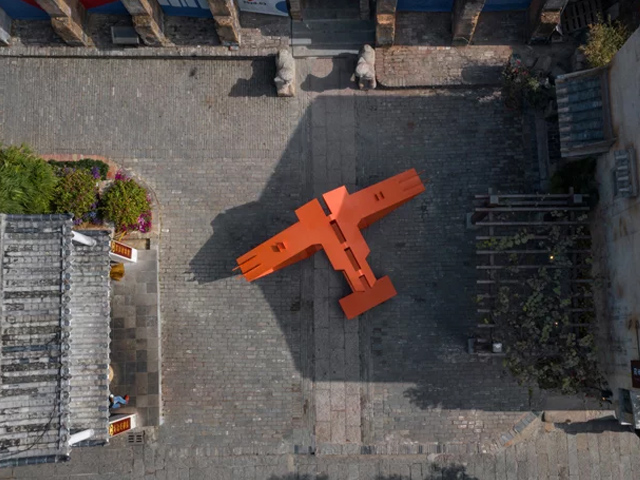FURNITURE? SCULPTURE? STAGE?
20 Feb 2020
Street furniture takes on an abstract flavour in this unique multipurpose piece designed by Studio Frank Havermans, created for the Shenzhen Bi-city Biennale of Urbanism and Architecture.

The architectural installation, titled KAPKAR/DPF-4B, was created specifically for the Shenzhen Bi-city Biennale - considered the world’s only exhibition that focuses explicitly on urbanism – which runs from December 2019 through March 2020.
An abstract rendering that draws on the surrounding architecture in a reinterpretation of local building elements, KAPKAR/DPF-4B makes a bold statement that isn’t just eye-catching because of its vibrant colour, its very structure draws you in. 
Like open arms, the extremities of the piece are thrown wide, providing a nice foundation for climbing (as it turns out), as well as an overhead canopy that offers shade. The centre stretch extends perpendicular to the arms, offering a seat to those passing through - even a makeshift stage.
Crafted of metal and painted a vivid shade of orange, the futuristic installation stands in stark contrast to its historical locale in the heart of Dapeng Fortress; an ancient walled village in the subdistrict of Dapeng. Located at the entrance to the exhibition, the site-specific structure serves as a meeting point for the community and a commentary on the local building culture, holding the past, present and future in one form. 
Located in The Netherlands and described as “an artist and designer who develops and makes strategic site specific interventions that can be considered as proposals for urban change”, Frank Havermans works predominantly in the world of architectural art, design and urban space. 
Working from the architectural context of the location, the Studio cites its use of location-specific elements in creating KAPKAR/DFP-4B as being from, “The buttresses of the granary, the stacking of architectural wooden structures in Chinese architecture, and the faint gable roofs that are everywhere present there. Also the elegant wooden mortise and tenon joint signs, present in historical architecture … with its orange colour, derived from the work clothes of the cleaners of Dapeng.” 
Softly lit at night, KAPKAR/DFP-4B is seating area, gathering place, performance stage, public art and playground all in one, offering something to everyone in the community. 
Images Li Yiting via Designboom

MORE NEWS

STONNINGTON SPORTS CENTRE

I SEE RED ... I SEE RED ... I SEE RED!!

CUSTOM-MADE CONCRETE SEATING ADORN THE NEW LUNA PARK & PALAIS THEATRE PRECINCT

MERCEDES BENZ NEWSTEAD

ENHANCING COMMUNITY SPACES AT NORWOOD GREEN IN ADELAIDE

